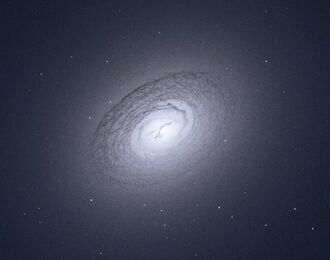Astronomy:NGC 3607
| NGC 3607 | |
|---|---|
 The nuclear dust disk of NGC 3607 as imaged by the Hubble Space Telescope | |
| Observation data (J2000 epoch) | |
| Constellation | Leo |
| Right ascension | 11h 16m 54.657s[1] |
| Declination | +18° 03′ 06.51″[1] |
| Helio radial velocity | 930 km/s[2] |
| Distance | 73.4 Mly (22.49 Mpc)[2] |
| Group or cluster | Leo II Group[3] |
| Apparent magnitude (V) | 10.8[4] |
| Characteristics | |
| Type | SA(s)0*[5] |
| Apparent size (V) | 4.9′ × 2.5′[4] (Optical) |
| Other designations | |
| NGC 3607, UGC 6297, PGC 34426, SDSS J111654.63+180306.3[6] | |
NGC 3607 is a small but fairly bright[7] lenticular galaxy[3] in the equatorial constellation of Leo, about 2.5° south of the prominent star Delta Leonis.[8] The galaxy was discovered March 14, 1784 by William Herschel. Dreyer described it as "very bright, large, round, very much brighter middle, 2nd of 3".[9] It is located at a distance of 73 million light years and is receding with a radial velocity of 930 km/s.[2] The galaxy lies southwest of NGC 3626 at an angular separation of ~50′.[7] It occupies the center of the Leo II Group of galaxies, forming one of its two brightest members – the other being NGC 3608.[3] It is a member of the NGC 3607 Group of galaxies, which is a member of the Leo II Groups, a series of galaxies and galaxy clusters strung out from the right edge of the Virgo Supercluster.[10]
The morphological class of NGC 3607 is SA(s)0*,[5] matching a lenticular galaxy (SA0) with no inner ring structure (s). It is an intermediate mass galaxy[3] that is being viewed at an inclination of 34°,[5] showing an ellipticity of 0.13 with the major axis oriented along a position angle of 125°.[3] The galaxy has an outer dusty disk with a second perpendicular disk that is falling inward toward the center of the galaxy.[3] X-ray emission from hot gas has been detected in the interior and from all around the galaxy.[5]
A system of 46 confirmed globular clusters have been identified around NGC 3607, which are orbiting within an effective radius of 14.2±2.0 kpc. In contrast, the stellar component of the galaxy has an effective radius of 4.2±1 kpc.[3] Orbital motions of this cluster system[11] imply an unusual poverty of dark matter: perhaps 16%±44% of the total mass within 5 effective radii. Its central black hole has a mass of M• = (1.2±0.4)×108 M☉[12] The core region of the galaxy is kinematically distinct from the remainder of the galaxy and shows an enhancement of magnesium.[5]
References
- ↑ Jump up to: 1.0 1.1 Skrutskie, Michael F. et al. (February 1, 2006). "The Two Micron All Sky Survey (2MASS)". The Astronomical Journal 131 (2): 1163–1183. doi:10.1086/498708. ISSN 0004-6256. Bibcode: 2006AJ....131.1163S.
- ↑ Jump up to: 2.0 2.1 2.2 Tully, R. Brent et al. (2016). "Cosmicflows-3". The Astronomical Journal 152 (2): 21. doi:10.3847/0004-6256/152/2/50. 50. Bibcode: 2016AJ....152...50T.
- ↑ Jump up to: 3.0 3.1 3.2 3.3 3.4 3.5 3.6 Kartha, Sreeja S. et al. (May 2016). "The SLUGGS survey*: exploring the globular cluster systems of the Leo II group and their global relationships". Monthly Notices of the Royal Astronomical Society 458 (1): 105–126. doi:10.1093/mnras/stw185. Bibcode: 2016MNRAS.458..105K.
- ↑ Jump up to: 4.0 4.1 "NASA/IPAC Extragalactic Database". Results for NGC 3607. http://nedwww.ipac.caltech.edu/.
- ↑ Jump up to: 5.0 5.1 5.2 5.3 5.4 Afanasiev, V. L.; Silchenko, O. K. (August 2007). "Leo II Group: decoupled cores of NGC 3607 and NGC3608". Astronomical & Astrophysical Transactions 26 (4): 311–337. doi:10.1080/10556790701553524. Bibcode: 2007A&AT...26..311A.
- ↑ "NGC 3607". SIMBAD. Centre de données astronomiques de Strasbourg. http://simbad.u-strasbg.fr/simbad/sim-basic?Ident=NGC+3607.
- ↑ Jump up to: 7.0 7.1 O'Meara, Steve (2007). Herschel 400 Observing Guide. Cambridge University Press. p. 131. ISBN 9780521858939. https://books.google.com/books?id=Nyh9fAC_tpIC&pg=PA131.
- ↑ Sinnott, Roger W.; Perryman, Michael A. C. (1997). Millennium Star Atlas. 2. Sky Publishing Corporation and the European Space Agency. p. 994. ISBN 0-933346-83-2.
- ↑ Seligman, Courtney. "NGC 3607 (= PGC 34426)". Celestial Atlas. https://cseligman.com/text/atlas/ngc36.htm#3607.
- ↑ "The Leo III Groups". Atlas of the Universe. http://www.atlasoftheuniverse.com/galgrps/leoii.html.
- ↑ Alabi, Adebusola B. et al. (2016-05-20). "The SLUGGS survey: the mass distribution in early-type galaxies within five effective radii and beyond". Monthly Notices of the Royal Astronomical Society 460 (4): 3838–3860. doi:10.1093/mnras/stw1213. Bibcode: 2016MNRAS.460.3838A.
- ↑ Gultekin, Kayhan (2009). "A Quintet of Black Hole Mass Determinations". The Astrophysical Journal 695 (2): 1577–1590. doi:10.1088/0004-637X/695/2/1577. Bibcode: 2009ApJ...695.1577G.
External links
- NGC 3607 on WikiSky: DSS2, SDSS, GALEX, IRAS, Hydrogen α, X-Ray, Astrophoto, Sky Map, Articles and images
Coordinates: ![]() 11h 16m 54.6s, +18° 03′ 07″
11h 16m 54.6s, +18° 03′ 07″
 |

